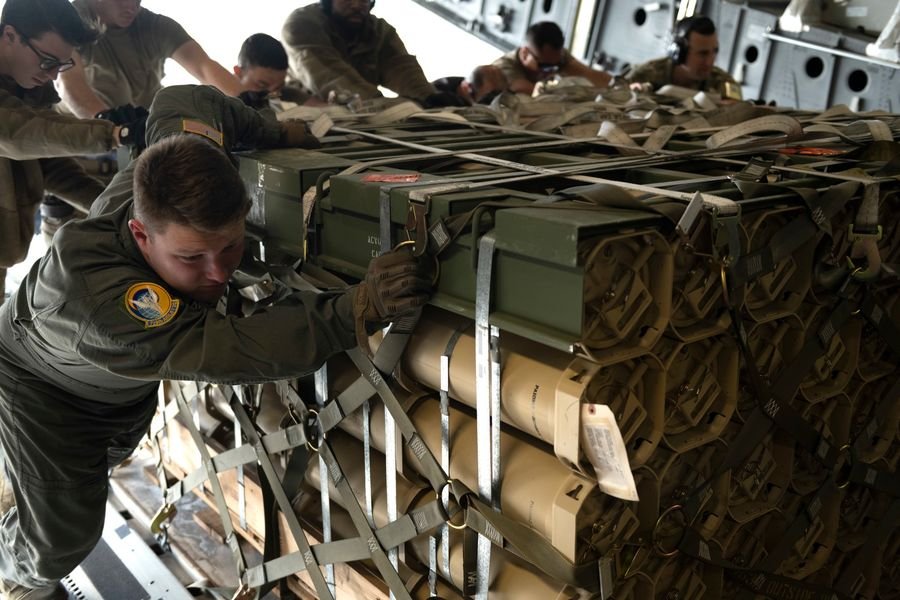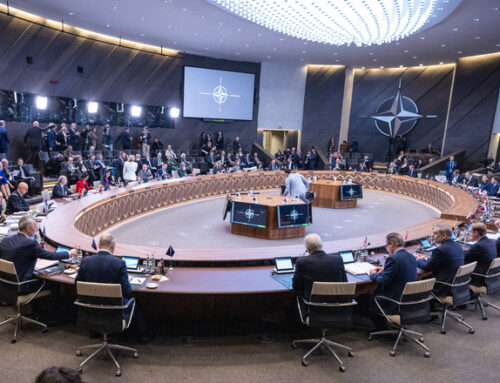Military Supplies
Autor foto: Ministry of Defence of Ukraine

Cluster munitions for Ukraine – Making a Difficult yet Necessary Decision
14 lipca, 2023


Military Supplies
Autor foto: Ministry of Defence of Ukraine
Cluster munitions for Ukraine – Making a Difficult yet Necessary Decision
Autor: Robert Czulda
Opublikowano: 14 lipca, 2023
A decision to transfer cluster munitions to Ukraine – banned by most states in the world (but not by the United States, Ukraine, and Russia) – is seen as a controversial move that highlights the problems of the Ukrainian army on the front line. However, this is not an unprecedented action, as claimed by some critics.
Cluster munitions, in this context, refer to canisters that are either dropped by aircraft or fired from land vehicles. These canisters contain tens or even hundreds of smaller bomblets, also known as submunitions. Canisters typically release submunitions at a predetermined altitude. Such weapons are used to attack large areas, such as military concentrations over an extensive area (including light vehicles or ammunition depots), or to damage runways, for example. Hardened targets and soldiers in trenches are relatively well protected against this type of munition.
When analysing the issue of cluster munitions, it is important to clarify that it is not a weapon universally prohibited by international conventions (like chemical or biological weapons). A withdrawal of this type of ammunition and its prohibition result from voluntary decisions of specific countries. This is regulated by the Convention on Cluster Munitions (CCM), which was adopted in 2008 in Dublin and came into effect two years later. The convention prohibits not only a use, but also transfer, production, and stockpiling of any type of cluster munitions.
So far, the Convention on Cluster Munitions has been signed by 123 states worldwide, with 111 of them ratifying it. However, notable states that have neither signed nor ratified the convention include the United States, China, and Russia. Interestingly, most of Russia’s neighbouring countries, including Poland, have not signed or ratified the document. The only exceptions are Norway and Japan. All of Russia’s neighbouring countries, which are threatened by aggressive and hostile actions from the Kremlin, remain outside the convention. This fact is significant. It also applies to Ukraine, which has not imposed any restrictions on itself resulting from the Convention on Cluster Munitions. This means that Ukraine can legally use this type of weapon while simultaneously complying with humanitarian law and international conventions that prohibit attacks on civilian targets, as such actions are illegal regardless of the means used.
Controversies
Cluster munitions, like anti-personnel mines, are considered inhumane weapons by most countries worldwide because they do not distinguish between civilian populations and military targets. One fundamental problem, as highlighted, for example, during the 2006 war between Israel and Hezbollah, is that many bomblets fail to explode and remain active after armed conflict ends. These bombs can become lodged in trees, bushes, or buried in the ground, posing a deadly and long-term threat to civilians living and working in a contaminated area. They can be accidentally activated even decades later. Their neutralisation is time-consuming and costly. An increased risk occurs when these bombs are dropped on inhabited areas rather than on deserted areas occupied by enemy forces.
Doubts and controversies primarily concern older ammunition with higher failure rates and without self-destruction mechanisms. Modern cluster munitions are equipped with self-destruction systems that render their components harmless if they fail to function as intended. According to Polish data, contemporary cluster munitions have a reliability rate of 97-99%. In a statement by the Polish Defence Minister in 2008, it was stated that “when used in accordance with the principles of international humanitarian law, particularly those contained in the Additional Protocols of 1977 to the Geneva Conventions, which specify precautionary measures to be taken during attacks, this ammunition does not pose a greater threat to the civilian population than other types of ammunition”.[1]
It is unknown what reliability rate systems transferred to Ukraine will have. Information varies. According to The Small Wars Journal, a so-called dud-rate of the DPICM (Dual-Purpose Improved Conventional Munition) is 3%, while for a newer system known as the C-DAEM (Cannon Delivered Area Effects Munition), it is below 1%.[2] However, according to The New York Times, while “the Pentagon said the weapons they would send to Ukraine had a failure rate of 2.35 percent or less, far better than the usual rate that is common for cluster weapons,” they also stated that “the Pentagon’s own statements indicate that the cluster munitions in question contain older grenades known to have a failure rate of 14 percent or more”.[3] In the case of 72 grenades in one shell (canister), this would result in 10 unexploded ordnances (UXOs) per one shell and 1.2 thousand UXOs for every 8,000 fired shells (Ukraine fires between 6,000 and 8,000 artillery shells per day).[4]
Political dimension
After a decision of the United States to transfer cluster munitions to Ukraine, many commentators opposing it noted that just a year ago, the U.S. administration criticised Russia for using this type of weapon in Ukraine. At that time, then-White House press secretary Jen Psaki used the term „war crimes.” However, the narrative presented in the media is false – the White House criticised not so much a use of cluster munitions itself but rather their indiscriminate use against a civilian population, which indeed bears hallmarks of war crimes. In 2022, Psaki stated that if there is evidence of „violence against civilians” through a use of cluster bombs and thermobaric weapons, it would potentially be considered a war crime.
Now Germany is opposed to transferring cluster munitions to Ukraine. Berlin’s objections should not be taken seriously, as Germany has been hindering the increase of aid to Ukraine since the beginning of the war, officially citing concerns about potential escalation or prolongation of the war. Nevertheless, it is impossible to ignore the fact that Canadians and Spaniards also express similar objections.[5] However, these countries do not have any means, including legal ones, to block such a transfer.
However, the fact that Russians were the first to use this type of ammunition in the war means that if Ukrainians were to start using US-made cluster munitions now, it could not be considered a dangerous precedent. Moreover, controversies are further diminished by the fact that Ukrainians have pledged not to use cluster munitions on Russian soil but only on their own territory. Although this may result in contamination of parts of Ukraine, it could contribute to a faster end to the war, ultimately saving more lives. Furthermore, a transfer of cluster munitions by Americans to Ukrainians will not set a precedent, as Turkey had previously supplied this type of weapon. According to available information, Ankara began sending the first batches of cluster artillery munitions in November 2022.[6]
As mentioned earlier, the United States has never signed the Convention on Cluster Munitions and possesses cluster munitions in its inventory. The US military has used them in multiple armed conflicts. Ukraine is expected to receive the DPICM system, which has been in use by the US military since the 1970s. It could be fired from standard 155 mm howitzers, which Ukraine has received from NATO member states (including Poland’s KRAB, Germany’s PzH2000, France’s CAESAR, or the US-made M109). There are also DPICM rounds that can be fired from 105 mm guns, which Ukraine has also been given.
Conclusions
A decision to provide Ukraine with such ambiguous, if not controversial and widely condemned, ammunition may indicate Ukraine’s problems in its war with Russia. Most likely, it is evidence of diminishing supplies of artillery ammunition for the Ukrainian army, as well as for allies, including the United States, which, despite increasing production, are unable to provide sufficient deliveries. This interpretation is supported by press reports suggesting that the United States has pressured Japan to provide its 155mm ammo.[7]
The Americans are not setting a precedent, as Ukrainians have already used this type of ammunition before. When it comes to moral issues and failure rates, one should not forget about proportionality and the fact that the Russians extensively use their own cluster munitions and deploy thousands of mines. They also create numerous traps, including those with hand grenades hidden in civilian houses. This is already a much bigger problem than potential unexploded ordnance from Ukrainian ammunition.
Nevertheless, regardless of Russia’s criminal actions, it should be noted that cluster munitions are always weapons with an increased risk (although lower than in the case of Russian cluster munitions, which have a much higher failure rate). For this reason, Ukraine must use them judiciously and with restraint, in order to minimise the risk to the civilian population, both currently residing in targeted areas and those who will live there in the future. This also requires proper training and appropriate use (for example, the dud rate increases if used in forests or mountainous terrains).
Future armed conflicts, especially potential clashes with Russia, which will not abandon this weapon, require – regardless of moral dilemmas – further development of cluster munitions and their introduction into service, especially by NATO frontline states. Only countries geographically distant from Russia can afford the luxury of abandoning cluster munitions and anti-personnel mines.
Author: Robert Czulda, Resident Fellow Casimir Pulaski Foundation
Supported by a grant from the Open Society Initiative for Europe within the Open Society Foundations
[1] „Odpowiedź ministra obrony narodowej – z upoważnienia prezesa Rady Ministrów – na interpelację nr 6918 w sprawie niepodpisania przez Polskę konwencji z Oslo o zakazie stosowania bomb kasetowych”, Sejm RP, January 6, 2009, http://orka2.sejm.gov.pl/IZ6.nsf/main/42994D77.
[2] Dan Rice, “Give Ukraine the “right artillery ammo:” DPICM”, Small Wars Journal, August 9, 2022, https://smallwarsjournal.com/jrnl/art/give-ukraine-right-artillery-ammo-dpicm.
[3] John Ismay, „Cluster Weapons U.S. Is Sending Ukraine Often Fail to Detonate”, The New York Times, July 7, 2023, https://www.nytimes.com/2023/07/07/us/cluster-weapons-duds-ukraine.html.
[4] Tara Copp, “Why the 155 mm round is so critical to the war in Ukraine”, Associated Press, April 23, 2023, https://apnews.com/article/155mm-howitzer-ukraine-ammunition-russia-7d966c85046b73db2b013f93c51af2a5.
[5] “Ukraine latest: Kremlin says Putin trip to China is 'on the agenda’”, Nikkei Asia, June 26, 2023, https://asia.nikkei.com/Politics/Ukraine-war/Ukraine-war-Free-to-read/Ukraine-latest-Putin-held-post-mutiny-talks-with-Wagner-leader-Prigozhin.
[6] Jack Detsch and Robbie Gramer, “Turkey Is Sending Cold War-Era Cluster Bombs to Ukraine”, Foreign Policy, January 10, 2023, https://foreignpolicy.com/2023/01/10/turkey-cold-war-cluster-bombs-ukraine.
[7] „US pushes Japan to provide 155mm ammo for Ukraine”, Shephard Media, July 6, 2023, https://www.shephardmedia.com/news/landwarfareintl/us-pushes-japan-to-provide-155mm-ammo-for-ukraine.






